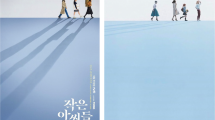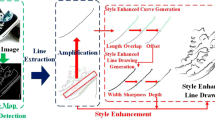Abstract
Line drawing is a means of superior visual communication which can effectively convey useful information to viewers. Artists usually draw what they see rather than what exists, which means the most attractive object is emphasized while the rest are inhibited. Moreover, artists draw the whole object with coherent lines instead of fractured lines, which also contribute to the outstanding visual effect. From these perspectives, generating line drawings with saliency and coherence remains a great challenge. Existing line drawing generation methods ignore these important properties and cannot generate coherent lines in some cases since they do not take into account how artists draw a picture. To this end, a novel saliency-aware line drawing method was proposed to better grasp the viewer’s attention on an image. First, a saliency enhanced line extraction method combining saliency map and edge tangent flow was proposed to ensure the saliency and coherence of lines, especially in salient but low contrast areas. Then, the salient information was highlighted while irrelevant details were eliminated by inhibiting lines in less salient areas to enhance the saliency of the line drawing. Finally, the transparency of lines was adjusted to further emphasize important information. Various results showed that our method can generate line drawings with better visual saliency and coherence than the state-of-the-art methods.
Similar content being viewed by others
References
Son M, Kang H, Lee Y, Lee S. Abstract line drawings from 2D images. In: Proceedings of IEEE Pacific Conference on Computer Graphics and Applications. 2007, 333–342
Zhou J, Li B. Automatic generation of pencil-sketch like drawings from personal photos. In: Proceedings of IEEE International Conference on Multimedia and Expo. 2005, 1026–1029
He J, Wang S, Zhang Y, Zhang J. A computational fresco sketch generation framework. In: Proceedings of IEEE International Conference on Multimedia and Expo. 2013, 1–6
Choi J, Cho H, Song J, Yoon S M. Sketchhelper: real-time stroke guidance for freehand sketch retrieval. IEEE Transactions on Multimedia, 2019, 21(8): 2083–2092
Hata M, Toyoura M, Mao X. Automatic generation of accentuated pencil drawing with saliency map and LIC. Visual Computer, 2012, 28(6–8): 657–668
Doug D, Anthony S. Stylization and abstraction of photographs. ACM Transactions on Graphics, 2002, 21(3): 769–776
Winnemoeller H, Xie J, Hertzmann A, Li W. Portraitsketch: face sketching assistance for novices. In: Proceedings of Annual ACM Symposium on User Interface Software and Technology. 2014, 407–417
Wu Y T, Yeh J S, Wu F C, Chuang Y Y. Tangent-based binary image abstraction. Journal of Imaging, 2017, 3(2): 16–30
Kang H, Lee S, Chui C K. Flow-based image abstraction. IEEE Transactions on Visualization and Computer Graphics, 2009, 15(1): 62–76
Orzan A, Bousseau A, Barla P, Thollot J. Structurepreserving manipulation of photographs. In: Proceeding of International Symposium on Non-Photorealistic Animation and Rendering. 2007, 103–110
Rosin P L, Lai Y K. Artistic minimal rendering with lines and blocks. Graphical Models, 2013, 75(4): 208–229
Kang H, Lee S, Chui C K. Coherent line drawing. In: Proceedings of International Symposium on NonPhotorealistic Animation and Rendering. 2007, 43–50
Wang S, Wu E, Liu Y, Liu X, Chen Y. Abstract line drawings from photographs using flow-based filters. Computers and Graphics, 2012, 36(4): 224–231
Li M, Lin Z, Mech R, Yumer E, Ramanan D. Photosketching: inferring contour drawings from images. In: Proceedings of Winter Conference on Applications of Computer Vision. 2019, 1–10
Liu Y, Cheng M M, Hu X, Wang K, Bai X. Richer convolutional features for edge detection. In: Proceedings of IEEE Conference on Computer Vision and Pattern Recognition. 2017, 3000–3009
Xie S, Tu Z. Holistically-nested edge detection. International Journal of Computer Vision, 2017, 125(1): 3–18
Sheng B, Li P, Gao C, Ma K L. Deep neural representation guided face sketch synthesis. IEEE Transactions on Visualization and Computer Graphics, 2019, 25(12): 3216–3230
Kang H W, Chui C K, Chakraborty U K. A unified scheme for adaptive stroke-based rendering. Visual Computer, 2006, 22: 9–11
Gooch B, Reinhard E, Gooch A. Human facial illustrations: creation and psychophysical evaluation. ACM Transactions on Graphics, 2004, 23(1): 27–44
Nie Y, Cao X, Li P, Zhang Q, Zhang Z, Li G, Sun H. Interactive contour extraction via sketch-alike densevalidation optimization. IEEE Transactions on Circuits and Systems for Video Technology, 2020, 30(4): 906–916
Wang S, Ao Z, Yao S, Chen Y, Wang G. Adaptive line drawing. Journal of Image and Graphics, 2018, 23(5): 730–739
Zhang J, Wani R Z, Xu D. Automatic generation of sketch-like pencil drawing from image. In: Proceedings of IEEE International Conference on Multimedia and Expo. 2017, 261–266
Li R, Sun S, Yang X, Hu W. Automatic generation of pencil drawings based on multi-level saliency maps. Journal of Computer-Aided Design and Computer Graphics, 2018, 30(1): 108–116
Alexe B, Deselaers T, Ferrari V. Measuring the objectness of image windows. IEEE Transactions on Pattern Analysis and Machine Intelligence, 2012, 34(11): 2189–2202
Yan Q, Xu L, Shi J, Jia J. Hierarchical saliency detection. In: Proceedings of IEEE Conference on Computer Vision and Pattern Recognition. 2013, 1155–1162
Gu K, Wang S, Yang H, Lin W, Zhai G, Yang X, Member S, Zhang W. Saliency-guided quality assessment of screen content images. IEEE Transactions on Multimedia, 2016, 18(6): 1098–1100
Huang Z, Liu S. Perceptual hashing with visual content understanding for reduced-reference screen content image quality assessment. IEEE Transactions on Circuits and Systems for Video Technology, 2021, 31(7): 2808–2823
Gao R, Huang Z, Liu S. Multi-task deep learning for no-reference screen content image quality assessment. In: Proceedings of the 27th International Conference on Multimedia Modeling. 2021, 213–226
Jerripothula K R, Cai J, Yuan J. Image co-segmentation via saliency cofusion. IEEE Transactions on Multimedia, 2016, 18(9): 1896–1909
Quan R, Han J, Member S, Zhang D, Nie F, Qian X, Li X. Unsupervised salient object detection via inferring from imperfect saliency models. IEEE Transactions on Multimedia, 2017, 20(5): 1101–1112
Zhao Y, Liu S, Hu Z, Bai Y, Shen C, Shi X. Separate degree based otsu and signed similarity driven level set for segmenting and counting anthrax spores. Computers and Electronics in Agriculture, 2020, 169: 1–15
Qian X, Wang H, Zhao Y, Hou X, Hong R, Wang M, Tang Y Y. Image location inference by multisaliency enhancement. IEEE Transactions on Multimedia, 2017, 19(4): 813–821
Fang Y, Lin W, Member S, Lee B S, Lau C T, Chen Z, Lin C W. Bottom-up saliency detection model based on human visual sensitivity and amplitude spectrum. IEEE Transactions on Multimedia, 2012, 14(1): 187–198
Imamoglu N, Lin W, Fang Y. A saliency detection model using low-level features based on wavelet transform. IEEE Transactions on Multimedia, 2012, 14(1): 187–198
Yang C, Zhang L, Lu H, Ruan X, Yang M H. Saliency detection via graph-based manifold ranking. In: Proceedings of IEEE Conference on Computer Vision and Pattern Recognition. 2013, 3166–3173
Achanta R, Hemami S, Estrada F, Susstrunk S. Frequency-tuned salient region detection. In: Proceedings of IEEE Conference on Computer Vision and Pattern Recognition. 2009, 1597–1604
Cabral B, Leedom L C. Imaging vector fields using line integral convolution. In: Proceedings of the 20th Annual Conference on Computer Graphics and Interactive Techniques. 1993, 263–270
Winnemller H, Gooch B, Olsen S C. Real-time video abstraction. ACM Transactions on Graphics, 2006, 25(3): 1221–1226
Jin Y, Li P, Wang W, Zhang S, Lin D, Yin C. Ganbased pencil drawing learning system for art education on large-scale image datasets with learning analytics. Interactive Learning Environments, 2019
Chen Z, Jin Y, Sheng B, Li P, Sun H. Parallel pencil drawing stylization via structure-aware optimization. In: Proceedings of the 31st International Conference on Computer Animation and Social Agents. 2018, 32–37
Jin Y, Li P, Sheng B, Nie Y, Kim J, Wu E. SRNPD: spatial rendering network for pencil drawing stylization. Computer Animation and Virtual Worlds, 2019, 30(3–4): 1–13
Song Z, Liu S. Sufficient image appearance transfer combining color and texture. IEEE Transactions on Multimedia, 2019, 19(4): 702–711
Liu S, Song Z, Zhang X, Zhu T. Progressive complex illumination image appearance transfer based on CNN. Journal of Visual Communication and Image Representation, 2019, 64: 1–11
Zhu T, Liu S. Detail-preserving arbitrary style transfer. In: Proceedings of IEEE International Conference on Multimedia and Expo. 2020, 1–6
Liu S, Zhu T. Structure-guided arbitrary style transfer for artistic image and video. IEEE Transactions on Multimedia, 2021
Li P, Sun H, Sheng B, Shen J. Image stylization with enhanced structure on GPU. Science China Information Sciences, 2012, 55(5): 1093–1105
Wang R, Li P, Sheng B, Sun H, Wu E. Real-time video stylization using spatial-temporal gabor filtering. In: Proceedings of the 15th ACM SIGGRAPH Conference on Virtual-Reality Continuum and Its Applications in Industry. 2016, 299–307
Acknowledgements
This work was partly supported by the National Natural Science Foundation of China (Grant Nos. 62072328 and 61672375).
Author information
Authors and Affiliations
Corresponding author
Additional information
Shiguang Liu received the PhD degree from the State Key Laboratory of CAD CG, Zhejiang University, China. He is currently a Professor with the School of Computer Science and Technology, Tianjin University, China. His research interests include image/video processing, computer graphics, visualization and virtual reality.
Ziqi Liu got his BS degree and ME degree from the School of Computer Science and Technology, College of Intelligence and Computing, Tianjin University, China. His research interests include line drawing synthesis and computer graphics.
Electronic Supplementary Material
Rights and permissions
About this article
Cite this article
Liu, S., Liu, Z. Line drawing via saliency map and ETF. Front. Comput. Sci. 16, 165707 (2022). https://doi.org/10.1007/s11704-021-1027-z
Received:
Accepted:
Published:
DOI: https://doi.org/10.1007/s11704-021-1027-z




